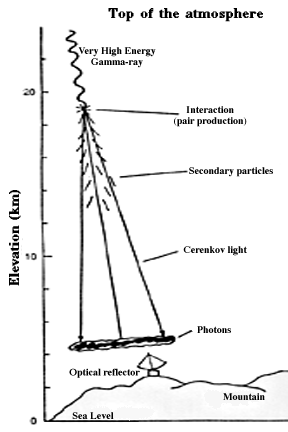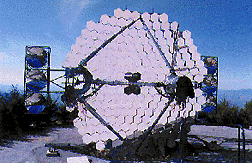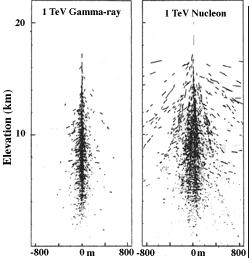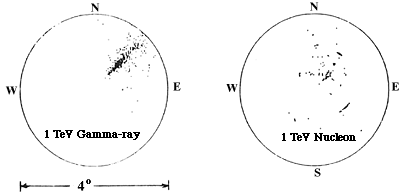

These are extremely energetic particles which means that they are traveling very close to the speed of light. In fact, these particles are traveling faster than the speed of light "in the medium of the atmosphere". Remember that nothing can travel faster than the speed of light "in a vacuum", but that the speed of light is reduced when traveling through most media (like glass, water, air, etc.). The resultant polarization of local atoms as the charged particles travel through the atmosphere results in the emission of a faint, bluish light known as "Cerenkov radiation", named for the Russian physicist who made comprehensive studies of this phenomenon.
Depending on the energy of the initial cosmic gamma-ray, there may be thousands of electrons/positrons in the resulting cascade which are capable of emitting Cerenkov radiation. As a result, a large "pool" of Cerenkov light accompanies the particles in the air shower. This pool of light is pancake-like in appearance, about 200 meters in diameter but only a meter or so in thickness. Air Cerenkov detectors, as the name implies, rely on the detection of this pool of light to detect the arrival of a cosmic gamma-ray.

|
|
A picture of the pioneering Whipple Observatory Air Cerenkov detector |
Once the light has been detected in a phototube, fast electronics are used to record the signal. Many modern detectors use an array of 100 or more small phototubes in the focal plane rather than a single phototube. In this way, a crude image of the Cerenkov light pool is recorded. This is very important because these detectors, in addition to detecting cosmic gamma-ray photons, detect a large cosmic ray background. Cosmic ray protons and nuclei interact in the atmosphere in much the same way, creating their own Cerenkov light pools. These cosmic ray induced showers come uniformly from all parts of the sky and seriously mask the desired photonic signal. Less than 1% of the events detected are due to photons rather than cosmic rays.
The latest generation of Air Cerenkov detectors have worked around this problem through the technique of imaging. Simulations of air showers show that the light collected from gamma-ray primaries differs from that produced by cosmic ray primaries in a few fundamental ways. The Cerenkov light collected from a gamma-ray shower has a smaller angular distribution and tends to have an ellipsoidal shape which aligns itself with the direction of the incoming photon. Cosmic-ray induced air showers, on the other hand, have Cerenkov light images which are much broader and less well aligned with the arrival direction. By measuring the shape of each shower image, and selecting only those events which are gamma-ray-like in appearance, nearly all the cosmic ray contamination can be removed, resulting in a much improved ability to detect an excess number of counts from the source direction.
 |
|
The particles in an air shower (above) are much more widely distributed
for proton versus gamma-ray showers. This is reflected in the
distribution of photons in the detector (below) |
 |
Incident photon energy is not well determined. Simulations typically show that the energy of the incoming gamma-ray can be estimated to about 30-40% accuracy. Unfortunately, the absolute energy threshold must also be determined through simulations. Time resolution is good, however, since the arrival time of the shower can be determined at the sub-millisecond level. Most detectors have relied on on/off observations to detect a source. In this mode, the detector looks at the region of the sky containing the source of interest for some period of time then alternates with a background region. An excess of events in the on versus off observations indicates a source detection. The advent of imaging detectors has changed this, however, and it is becoming possible to detect a source in the field-of-view without background subtraction. In this mode, sources can be located to within a few arc-minutes, good even by satellite-borne gamma-ray instrument methods.
Future developmentsAs with more conventional detectors, larger is better. Many researchers are looking into arrays of reflectors which cover areas on the order of hundreds of meters on a side to greatly increase the collecting area, improve the measurement of image parameters, and decrease the energy threshold of these instruments. In addition, it could prove possible to further enhance the ability to distinguish gamma-ray from cosmic-ray showers based on the spectral content of the shower light or on a timing analysis of the shower development. |
|
Any Suggestions, mail to: emrah@astroa.physics.metu.edu.tr